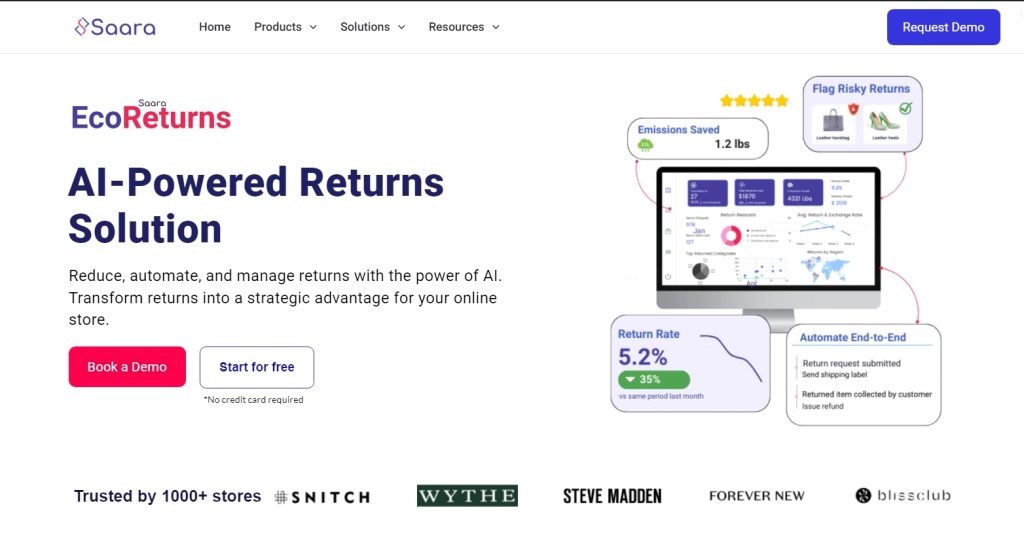In the labyrinth of eCommerce, where algorithms dictate consumer behavior and virtual storefronts compete for attention, lies an often-untapped source of revenue growth: returns. Yes, you heard it right—those seemingly inconvenient, reverse journeys of products back to merchants harbor immense potential for businesses willing to decode their true value.
Picture this: A customer receives a product, not quite what they envisioned. In the traditional narrative, this scenario spells inconvenience and lost revenue. But what if I told you, it could be the catalyst for something far greater? Welcome to the unexplored frontier of eCommerce returns—a domain where retained revenue growth thrives amidst the chaos of reverse logistics and consumer whims.
In this blog series, we embark on a voyage of discovery, peeling back the layers of misconception to reveal the hidden goldmine that is eCommerce returns. From dissecting the psychology of return behavior to unveiling innovative strategies for capitalizing on this oft-overlooked facet of online retail, we leave no stone unturned in our quest for enlightenment.
The Psychological Drivers of Return Behavior
eCommerce Returns are not merely transactions but reflections of consumer emotions and decision-making processes. Several psychological factors contribute to return behavior, including:
- Perceived Risk: Customers may perceive higher risk when purchasing products online, leading to increased likelihood of returns as a form of risk mitigation.
- Expectation-Reality Mismatch: Discrepancies between product expectations and reality can result in dissatisfaction and subsequent returns.
- Social Influence: Social factors, such as peer recommendations or societal norms, can influence purchase decisions and subsequent return behavior.
How eCommerce Returns have affected the Revenue:
Returns can significantly impact eCommerce revenue, with studies indicating that return rates can range from 15% to 40% for online purchases. According to a National Retail Federation report, returns constitute $816 billion in lost sales for U.S. retailers. This amount surpasses the expenditure of the U.S. federal government on education, training, and employment programs in 2022.
These returns pose a considerable financial challenge for eCommerce merchants, as the costs associated with processing returns, restocking inventory, and potential revenue loss can add up quickly.
A study conducted by Invesp revealed that approximately 30% of online purchases end up being returned, significantly impacting merchants’ bottom lines. Beyond direct sales losses, returns also incur additional costs, including reverse logistics, restocking fees, and inventory depreciation.
High return rates can result in lost revenue opportunities, as returned items often cannot be resold at full price and may require markdowns or clearance sales to move inventory.
In today’s competitive eCommerce landscape, where profit margins are often razor-thin, the financial implications of returns underscore the urgency for merchants to implement effective strategies for managing and mitigating their impact on revenue.
By implementing innovative strategies, businesses can transform eCommerce returns from a potential challenge into an opportunity for engagement, growth and retained revenue. Let’s explore key strategies for optimizing returns management, starting with building trust through transparent policies.
Building Trust Through Transparent Policies:
Transparency breeds trust, and nowhere is this more evident than in return policies. By clearly communicating return terms and conditions, including ease of process and timelines, businesses can alleviate customer concerns and instill confidence in their purchasing decisions.
A fair and transparent return policy reassures customers that their satisfaction is paramount, fostering trust and loyalty in the brand. Implementing such policies not only reduces the likelihood of ecommerce returns but also contributes to retained revenue by encouraging repeat purchases. For Shopify merchants, ensuring a clear and customer-friendly Shopify return policy is essential for building a positive brand reputation and fostering long-term customer relationships.
Using Returns as a Tool for Customer Engagement:
eCommerce returns present a unique opportunity for customer engagement and relationship-building. By personalizing the returns experience and offering alternatives such as exchanges or store credits, businesses can turn a potentially negative interaction into a positive one. Engaging with customers during the returns process not only demonstrates care and attentiveness but also provides valuable insights into their preferences and needs.
Using returns as a customer engagement tool not only minimizes the impact of ecommerce returns but also contributes to retained revenue by enhancing customer satisfaction and loyalty. Shopify merchants can capitalize on this opportunity by integrating personalized return options into their Shopify return policy, thereby strengthening their relationship with customers and driving repeat purchases.
Optimizing the Returns Journey for Enhanced Satisfaction
Streamlining the returns process is key to enhancing customer satisfaction and loyalty. From offering multiple return options to providing pre-paid shipping labels and hassle-free returns, businesses can remove friction points and make the experience as seamless as possible. A smooth return journey not only encourages repeat purchases but also strengthens brand perception and loyalty.
By optimizing the returns journey, businesses can minimize the impact of eCommerce returns on their bottom line and maximize retained revenue. Shopify merchants can leverage Shopify returns management apps and integrations to streamline the returns process and enhance customer satisfaction, thereby driving long-term success in the competitive eCommerce landscape.
Harnessing Data for Strategic Decision-Making:
Data is a powerful tool for understanding return patterns and trends. By analyzing return data, businesses can identify root causes of returns, identify areas for improvement, and tailor their product offerings and marketing strategies accordingly. Leveraging data-driven insights enables businesses to make informed decisions that drive customer satisfaction and long-term success.
By harnessing data for strategic decision-making, businesses can optimize their return management processes, minimize the impact of ecommerce returns, and maximize retained revenue. Shopify merchants can utilize Shopify analytics tools and integrations to gather valuable return data and insights, enabling them to make data-driven decisions that drive growth and profitability
Innovative Technologies for Returns Management:
Embracing innovative technologies such as AI-powered returns management solutions can revolutionize the way businesses handle returns. These platforms automate and streamline the returns process, reducing administrative burden and providing valuable analytics to optimize operations. By leveraging cutting-edge technologies, businesses can enhance efficiency, reduce costs, and deliver exceptional customer experiences.
Shopify merchants can integrate AI-powered returns management solutions into their Shopify store to automate return processing, optimize inventory management, and enhance customer satisfaction. By embracing innovative technologies for returns management, businesses can minimize the impact of eCommerce returns on their bottom line and maximize retained revenue, driving long-term success in the competitive ecommerce landscape.


EcoReturns is an AI-Powered Returns Solution reshaping your online store’s returns process. With advanced AI, it streamlines, automates, and manages returns seamlessly, becoming a strategic asset. Bid farewell to returns fraud with EcoReturns’ potent AI engine flagging risky customers.
Utilizing a 3-layered returns reduction technology, EcoReturns minimizes returns and associated costs through AI-powered incentivization and ChatGPT assistance, fostering brand growth. No more manual handling – EcoReturns’ automation rules streamline reverse shipments, exchanges, and refunds, boosting efficiency.
Additionally, EcoReturns offers site-wide exchanges, allowing seamless product swaps within your website, incentivizing customers with store credits. Embrace the future of returns management with EcoReturns, elevating your online store’s efficiency and customer satisfaction to unparalleled heights.
The Returns Effect: Understanding the Power of Returns
Building Trust Through Returns
Consider this: According to industry research, customers who have positive return experiences are more likely to become repeat buyers, often spending more per transaction than first-time purchasers. This phenomenon, known as the “returns effect,” underscores the significant role that returns play in shaping consumer behavior and long-term brand loyalty.
The Confidence Factor
At its core lies the concept of trust. When a customer knows they can easily return or exchange a product that doesn’t meet their expectations, it instills a sense of confidence in the purchasing process. This assurance encourages them to take the plunge and make a purchase, knowing that they have an exit strategy should the need arise.
Optimizing Returns for Revenue Growth
Streamlining Logistics and Minimizing Expenses
Now, you might be wondering, how can businesses harness the returns effect to drive retained reenue growth? The answer lies in strategic optimization of the returns process, from start to finish. This involves not only streamlining logistics and minimizing return-related expenses but also leveraging returns as an opportunity to engage customers and foster brand loyalty.
Embracing Site-Wide Exchanges for Growth
Embracing site-wide exchanges is key for e-commerce growth. By promoting products across your website, you enhance visibility, simplify the shopping experience, and boost sales. This strategy also opens doors for collaboration and cross-promotional opportunities, while offering flexibility and incentives reduces returns and fosters customer loyalty.
EcoReturns, an AI-Powered Returns Management Solution, goes beyond automating returns to include site-wide exchanges, enhancing e-commerce efficiency The platform provides valuable data and insights into customer behavior, enabling informed decisions to minimize returns and enhance satisfaction
Differentiation Through Returns: Leveraging Customer Experience
A Competitive Edge
Moreover, a seamless returns experience can serve as a powerful differentiator in today’s crowded e-commerce landscape. With competition fierce and consumers expecting nothing short of excellence, businesses that prioritize customer satisfaction at every touchpoint, including returns, gain a distinct advantage.
Signaling Commitment to Customer Satisfaction
Offering hassle-free returns signals a commitment to customer satisfaction. Merchants demonstrate their dedication to delivering a superior shopping experience by prioritizing convenience and ease for their customers. This commitment fosters trust, loyalty, and long-term relationships, highlighting the merchant’s focus on customer-centricity in the competitive e-commerce landscape.
In Conclusion:
In summary, navigating the complexities of e-commerce returns unveils numerous opportunities for businesses to drive revenue growth and foster customer loyalty. By embracing transparent policies, personalized experiences, and innovative technologies like EcoReturns, merchants can transform returns into strategic assets. With a strategic approach to returns management, businesses can build trust, enhance satisfaction, and differentiate themselves in the competitive e-commerce landscape, ultimately driving long-term success and profitability.



